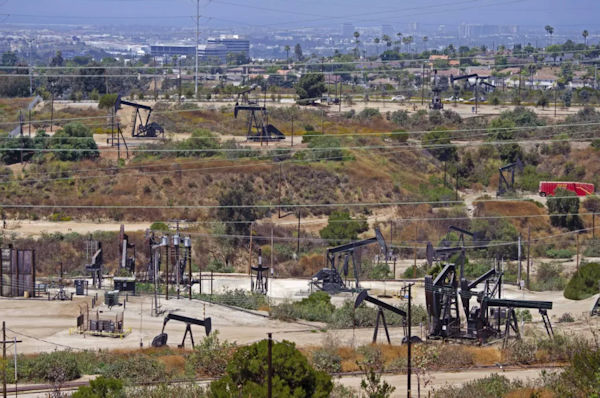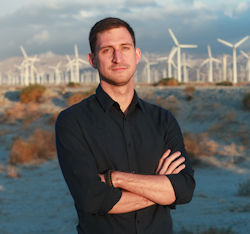SEJournal Online is the digital news magazine of the Society of Environmental Journalists. Learn more about SEJournal Online, including submission, subscription and advertising information.
 |
| Fossil fuel companies are leaving thousands of oil and gas wells unplugged and idle across California, potentially threatening the health of nearby residents and creating billions in taxpayer expenses for the cleanup. Above, Inglewood Oil Field in Los Angeles County. Photo: Center for Public Integrity/Mark Olalde. |
Inside Story: Investigation Into Dry Oil Wells Reveals High Risks, Costs to Nearby Neighborhoods
A collaborative journalism partnership analyzed government data on dry oil wells in dense California neighborhoods, revealing serious issues for surrounding low-income communities. And that coverage, by Mark Olalde and Ryan Menezes, won the pair second place for the Kevin Carmody Award for Outstanding Investigative Reporting, Large Market, in the Society of Environmental Journalists’ 20th Annual Awards for Reporting on the Environment.
Judges said of the project, "This collaborative investigation produced by the Center for Public Integrity and the Los Angeles Times revealed that the 35,000 dry oil wells across California require a massive cleanup. … Among the risks posed by these wells sitting in dense neighborhoods are the leak of noxious fumes as well as the risk that at any point the wells could prompt potentially catastrophic blowouts and explosions….Regulators forced one oil company to plug a well that was the subject of the series' reporting and public officials are pushing for more stringent regulations as a result of the series."
SEJournal Online recently caught up with Olalde. Here is the conversation.
SEJournal: How did you get your winning story idea?
Mark Olalde: On most mornings, I'd wander into an editor's office with a cup of coffee for a meandering chat about journalism and the environment. One day, he asked if I had any investigative ideas in California. Nope. So, I picked a topic that interested me — oil — and took a few weeks to check production statistics, call regulators, chat with activists and read clips — anything to spark me. Between the data and the conversations, the reality of the state's oil industry pretty quickly came into focus.
We combined as much government and industry data
as we could … so we could begin lobbing queries
at it that arose from our on-the-ground reporting.
SEJournal: What was the biggest challenge in reporting the pieces and how did you solve that challenge?
Olalde: The strength and the difficulty of this piece were both centered on its massive data work, which led to novel findings. We successfully tackled this challenge with a smart organization of our team and delineation of responsibilities. On one side, I was an expert in the extractive industry, and on the other, Los Angeles Times reporter Ryan Menezes was an expert on all things data. We spent time at the outset identifying what data resources existed, what they told us, how they could be joined and how we could access them. Then, we combined as much government and industry data as we could — crashing a computer in the process — so we could begin lobbing queries at it that arose from our on-the-ground reporting.
SEJournal: What most surprised you about your findings?
Olalde: The regulatory side of the government was asleep at the wheel in terms of protecting taxpayers from future environmental cleanup costs of the oil and gas industry. While Ryan's data work was very impressive, I didn't see a real reason the government hadn't attempted something similar years ago and was slow to make their findings publicly available when they did begin doing more data analyses recently.
We decided that the people whose lives were impacted
by living near this unplugged oil and gas extractive
infrastructure needed to be heard early and often in the series.
SEJournal: How did you decide to tell the series and why?
Olalde: We decided that the people whose lives were impacted by living near this unplugged oil and gas extractive infrastructure needed to be heard early and often in the series, so we did our best to highlight them, including through the work of the Los Angeles Times' amazing photography department.
SEJournal: Does the issue covered in your series have a disproportionate impact on people of low income, or people with a particular ethnic or racial background? What efforts, if any, did you make to include perspectives of people who may feel that journalists have left them out of public conversation over the years?
Olalde: Combining data from the Census and California oil regulators, we analyzed the demographics of people living close enough to oil and gas wells that their health is likely impacted. We also spent significant time in the field and made sure to have the right people in the room to be able to conduct interviews in Spanish, so we could hear the voices of Latinos who are often most directly affected by environmental health issues in California.
SEJournal: What would you do differently now, if anything, in reporting or telling the stories and why?
Olalde: This is one of those series that I look back on proudly. But perhaps we could've broken things down even further into more and smaller stories to help people better understand the complex data findings.
Traditional print reporters need to make specialty teams
— data, visuals, developers — partners on projects.
Do that and a project's possibilities are endless.
SEJournal: What lessons have you learned from your project?
Olalde: Traditional print reporters need to make specialty teams — data, visuals, developers — partners on projects. Do that and a project's possibilities are endless.
SEJournal: What practical advice would you give to other reporters pursuing similar projects, including any specific techniques or tools you used and could tell us more about?
Olalde: Go further than what environmentalists say. If they're correct, data will bear that out.
SEJournal: Could you characterize the resources that went into producing your prize-winning reporting (estimated costs, i.e., legal, travel or other; or estimated hours spent by the team to produce)? Did you receive any grants or fellowships to support it?
Olalde: This series took about six months to complete, with the two lead reporters putting half or more of their time toward it.
 |
Mark Olalde is an environment reporter with ProPublica's Southwest team and an adjunct faculty member at the Walter Cronkite School of Journalism and Mass Communication at Arizona State University.
His investigations have also appeared in the Los Angeles Times, USA Today, High Country News, the Center for Public Integrity and numerous other news outlets. He has reported from across the United States, the Caribbean and southern Africa.
And somewhere in South Africa (likely buried in his colleague's garage), an environment reporting award sponsored by a beer company has his name on it.
* From the weekly news magazine SEJournal Online, Vol. 7, No. 19. Content from each new issue of SEJournal Online is available to the public via the SEJournal Online main page. Subscribe to the e-newsletter here. And see past issues of the SEJournal archived here.













 Advertisement
Advertisement 



